How to Do the Best Brainstorming
Apr 24, 2023
Sitting through a “worst practices” brainstorming is frustrating and pointless. This article gives you a step-by-step process for best practice brainstorming.
This process works. It’s fun. And it produces results. It’s the basis for many processes that Critical to Success will describe in other articles. For example, you can expand on this brainstorming process to help with,
- Strategic objectives
- Metrics
- Work Breakdown Structures (task lists) for projects
- Root cause analysis to identify the cause of problems
- New product and feature development
- Marketing campaigns
- Bazillion’s of additional ideas…
I got my first taste of this process in an excellent workshop for facilitators taught by Jane Stallman, Sr. Partner at the Center for Strategic Facilitation in Oakland, California. They have excellent courses on facilitating processes to build consensus. With CSF’s core training under my belt about ten years ago I’ve since adapted their techniques for many team processes including brainstorming, root cause analysis, group decision making, and aligning disparate groups. Jane and CSF do great work!
A Better Brainstorming Process
Here are the steps for a basic brainstorming process that works far better than any other I’ve seen. This method lets everyone’s ideas surface, gives equal visibility to the quietest person in the room and the Highest Paid Person in the Room (HiPPO). It keeps the dominators in control, surfaces the quiet brilliant ideas, allows grouping and prioritization, and almost does the documentation for you. Sounds like a perfect package, doesn’t it!
Have a Single Meeting Leader
The meeting leader should not be the HiPPO or manager or team leader. The leader should be a facilitator who is objective and who will not weight one idea or individual above another. HiPPOs or managers can easily sway a direction with a subtle nod or smile at what they think is a good idea.
Develop a Well-Defined One Sentence Brainstorming Objective
The facilitator should work with the key stakeholders to develop a well-defined one sentence objective for the brainstorming. This objective should be posted as a banner across the front of the room. Examples are,
- Implement by end of year process to increase average customer retention to 18 months.
- Within six months increase the number of webinars delivered from 2 per month to 4 per month.
- Reduce time to completion by two months on the Gamma Project while staying within scope.
- Identify the 10 most probable causes of failure in the Sting Ray product.
Schedule the Meeting
Invite eight to twelve people. These should be stakeholders who are highly experienced in the topic, but are cross-functional. Cross-functional people will deliver a wider variety of solutions than if everyone in the room has the same experience and background.
Let everyone know the objective of the meeting. Give them the tip that for two days prior to the meeting they should carry 3 X 5 cards with them and write down their ideas. THEY SHOULD DO NOT COME TO A CONSENSUS BEFORE THE MEETING. You do not want people talking together prior to the meeting and coming up with a pre-arranged agreements. Let them know that everyone will get their ideas heard in the meeting.
Handle Difficult People Before the Meeting
If you have people who might be difficult in the meeting, discuss with them ahead of time how the meeting will work. The purpose is not to drive to a single winning idea (THEIRS), but rather to generate a lot of ideas, narrow the list to the best, and then identify the ideas to act on. Tweak their self-interests by informing them that if their idea is select from during this process then it will prove it is the best one and everyone will be onboard.
In one facilitation with a team of senior executives, an Executive Vice President talked to me the day before the meeting about why his idea had to “win”. I stayed neutral in response. In the meeting we started with brainstorming, went through an affinity diagram process similar to this, and then a ranking and prioritizing process. After a tough and sweaty half-day of hard work the team came up with their prioritized corporate objectives for the next year. The same VP came up to me after the meeting and told me, “My objective and its projects came up as fourth priority, but after seeing everything together and hearing all the discussion now I know why the others are ahead and I support them.”
Prepare the Meeting Room
Pick a room in neutral territory that will comfortably fit eight to twelve people. Make sure there’s good air conditioning. Ask everyone to set their phasers to stun, and turn off cell phones and heart pacemakers. For the following exercise you’ll need a large wall or whiteboard on which you can put Post-It Notes ™.
- Post a banner with the objective over the wall where you will put up Post-It Notes.
- Each person should have a black dry erase marker. (If we ever have a chance to meet, remind me to tell you how I ruined one of the first whiteboards in the state of California.)
- Use large 6” X 8” super sticky 3M Post-It notes and Expo dry erase pens.
The large horizontal, unlined Post-Its that are half the size of US letter allow for writing that can be seen across the room. (I’ve tried third-party store brand sticky notes and, sorry, but they just aren’t as good as Post-It notes.) Expo dry erase pens allow for an “Oops” that won’t permanently disfigure a meeting table or white board. (I have no affiliation with these products. I just like them and use them – a lot.)
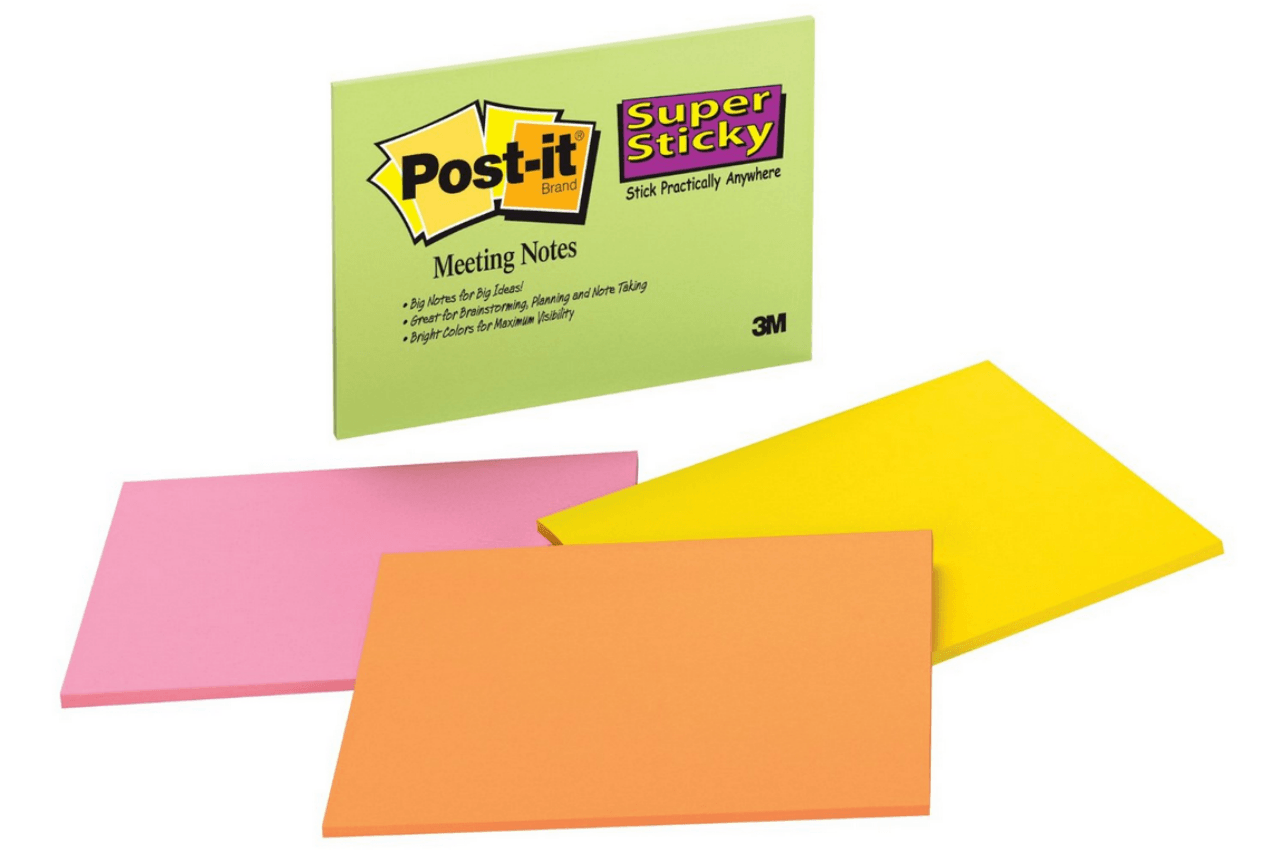
- How many Post-Its and People? In most team meetings I recommend eight to 12 people. A brainstorming meeting might have as few as five. More than 12 and you’re into a long meeting of talking.
- A wall for the Post-It notes should hold about 40 notes. So, that means if you have eight people each will get five notes. If you have 12 people, each can have three notes.
Discuss the Brainstorming Objective
Describe the objective so everyone is clear what ideas should focus on. Let everyone know the objective was defined by the stakeholder’s.
Let everyone know there will be lots of discussion later and everyone will be heard, but at this point no one should discuss their ideas.
Everyone should “Brainwrite” for Three to Five Minutes
Brainwriting is free flow writing where each individual writes their ideas on a pad. There should be NO TALKING during this time. They can use ideas they’ve written previously on 3” X 5” note cards.
Individually Write Ideas on Post-It Notes
The next step is for everyone to transfer their individual brainwriting to a Post It Note. But, there are a few rules on writing these. If people don’t write on the notes correctly it slows the process. Post these “Rules” in clear view on the wall.
- Each Post-It note should have one idea of 3 to 5 words in bold, block print.
- Someone in the room will attempt to write a thesis in small print so explain why you want 3 to 5 words. Bold and 3 to 5 words insures the idea is concise and readable across the room. One of your most common problems will be people wanting to write their novel on their Post-Its. If they can’t describe it in three to five words, then they haven’t focused it well enough. There will be time for discussion and details.
- Block print makes it hard to tell whether the idea came from, the HiPPO or the quiet new person in the corner.
- One idea per note allows ideas to be grouped and regrouped by moving Post-It notes around.
Pass Out Post-It Notes and Individually Write Ideas
Give everyone three to five minutes to write their ideas. Watch people and give them some leeway to finish their Post-It notes.
- About the greatest number of Post-Its a wall will hold is 40. So if you have eight people each gets five notes. If you have 12 people each gets three. It’s Ok for people to use a few notes to rewrite their idea on.
- No Talking! There will be lots of discussion in a few minutes.
Break the Team into Smaller Groups for Discussion and Note Selection
Break the large group into smaller groups of three or four people. These groups will discuss their ideas and pick the “best” 50% from their notes.
- Give each group about ten minutes to pick the “best” half of the notes from their group.
- Do not tell the groups, but the purpose of this selection process is to push the groups into discussing all of their ideas. This builds understanding and consensus around the top ideas.
- Twenty ideas for the entire team is half the 40 total Post-Its. If there are four groups, then each group would pick 5 from their Post-Its
(20/4 = 5). If there are two groups, then each would pick 10 (20/2=10). - Tell them to keep duplicates. “All Post-Its will eventually go up. Don’t throw any away.”
- Rewriting to make an idea clear or more concise is Ok.
- If someone asks what you mean by “best”, tell them that is up to them to decide. For you to know and for them to find out is that real purpose is not prioritizing by some criteria, but to discuss.
Pick Up The “Best Ideas” From The Groups.
As you pick up from each group, stick their notes on a wall forming a giant “smiley face” across the bottom of a smooth wall or white board. The “smiley face” will give you room in the top center to move notes around.
Picking up the notes in this fashion makes it easy to mix the HiPPO cards and notes from less powerful people.
As you post each note, read it aloud and ask if everyone understands. Do not put a value judgment on a note. I once said, “Wow! That’s a really great idea!” In that case I was not an impartial facilitator, I was an unbalanced facilitator.
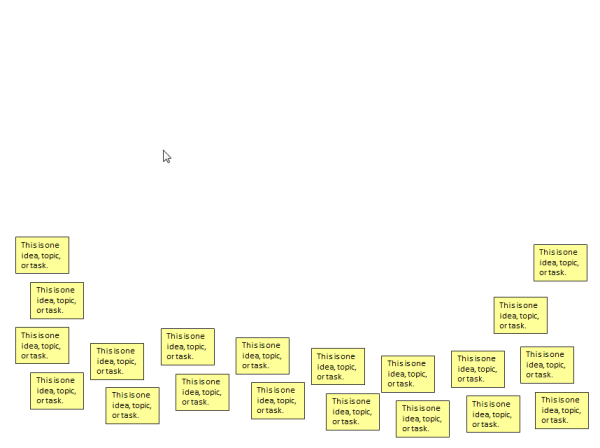
Post the brainstorming Post-It Notes on the wall in a smiley face.
Play a TV Matching Game And Ask The Team To Help You Group Ideas.
Ask people to help you group PAIRS of ideas that have a similar intent. Only create pairs. If your first groupings of notes are too large, people will subconsciously want to permanently keep them together.
Some ideas might not match others. That’s Ok.
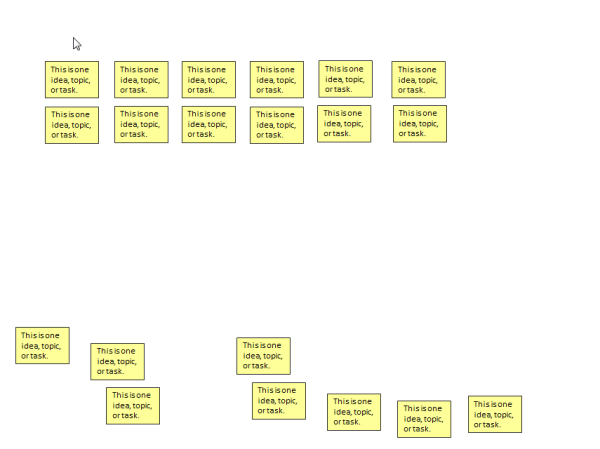
Put “Idea Icons” As Labels At The Top Of Groups For Easy Identification
As the facilitator you’re at the front of the room being told where to move notes. It can be tough to know which group of notes people are talking about. To fix this problem ahead of time I create a set of about 12 notes of a different color from the idea notes, e.g. all reds, that have icons on them like, sun, moon, car, plane, triangle, circle, etc. Use these “idea icons” as headings for groups of notes on the wall. Then you’ll hear things like, “Put that note under the circle.”
![]()
Ask For All The Post-It Notes.
Pick up and stick the remaining notes across the bottom of the wall.

Continue Grouping Post-It Notes
Now build on the existing groups and make new groups of notes with similar intent. Continue moving and grouping ideas until everyone agrees each group has the same intent.
It’s rare to have fewer than six groups or more than ten. And there are always a few outliers that are single notes by themselves.
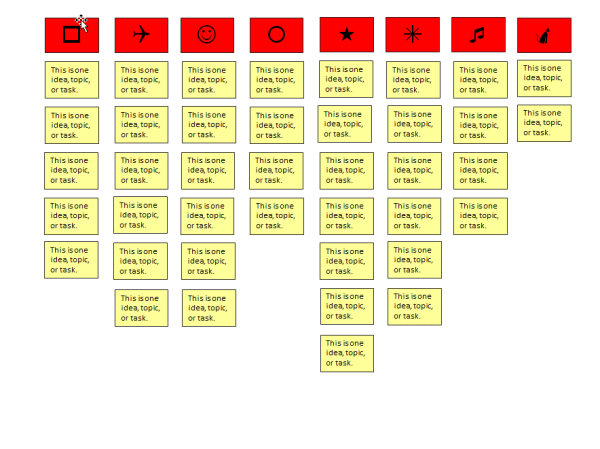
Spend About Ten Minutes Replacing The “Idea Icons” With Three To Five Word Titles.
These titles are not necessarily the final titles, but they will give the team easy descriptions to use.
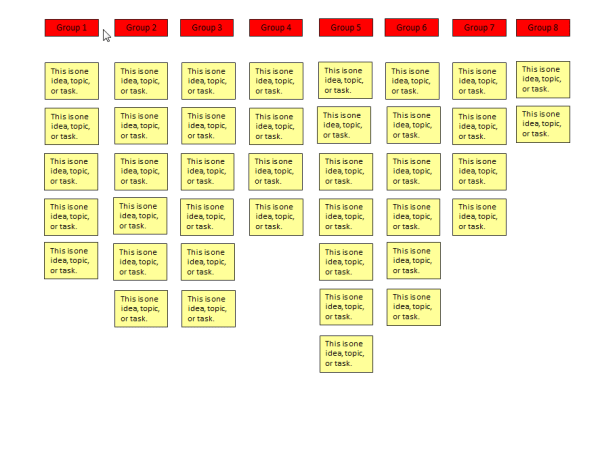
Finish The Brainstorming.
Now that you have a foundation of ideas you can be specific about what actions to take. Now is when the meeting should turn to,
- Prioritizing idea groups according to impact, resource requirements, risk, etc.
- Developing or sub-dividing an idea group adding more detail
- Brainstorming risks and resources for each idea group
- Assigning individual responsibilities
- Defining time frames
Archive, Document, Communicate
At this point you can take the ideas you’ve generated many directions. The ideas the group has generated should be a good base for task lists, project management Work Breakdown Structure, marketing campaigns, and more. Of course, this is just a beginning so some things you will want to do are,
- Archive – Use a SmartPhone to capture all the ideas, their groupings, and titles before taking them down from the wall. When you do take them down stack them in groups with the title of each group on top. (Yeah, I’m usually prepared for disasters and almost made Eagle Scout. I’m also paranoid about losing the thousands of dollars of work time a meeting takes up.)
- Document – Transcribe your archive into a color-coded Excel worksheet that’s a clean version of what you had on the board.
- Communicate – Send it out to team members and stakeholders.
Review
Get the stakeholders and a few key team members together in a week, after the neurons have had a chance to do some background recalculating, and go through the work. After that you should have a darn good result.